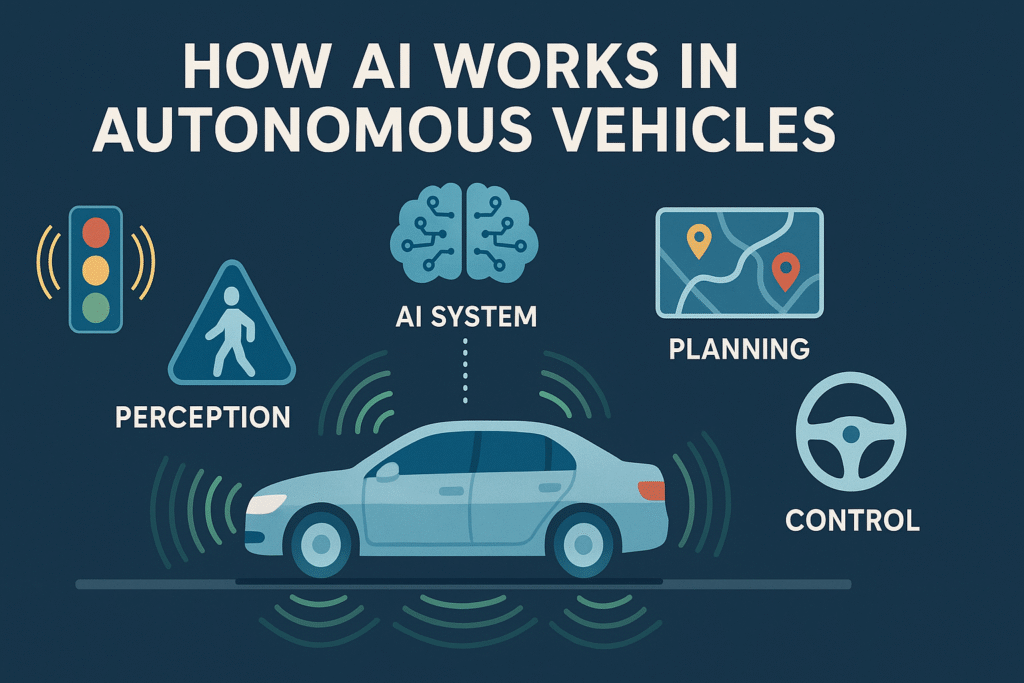🚗 How AI Works in Autonomous Vehicles: 7 Core Technologies Driving the Future
Explore how AI works in autonomous vehicles using sensors, machine learning, and real-time data to enable safe self-driving. Full breakdown by AiBlogQuest.com.
🧠 Introduction: AI Is the Brain Behind the Wheel
The idea of self-driving cars is no longer science fiction. From Tesla’s Autopilot to Waymo’s robo-taxis, AI is at the heart of autonomous vehicles.
But how does it all work?
At AiBlogQuest.com, we explain how AI works in autonomous vehicles, breaking down the sensors, neural networks, and algorithms that make smart driving possible in 2025.
🔧 7 Key Technologies Showing How AI Works in Autonomous Vehicles
1. 📡 Perception: Seeing the Road with Sensors
AI-powered vehicles use multiple sensors to perceive their environment, including:
-
LIDAR: Light-based radar for 3D mapping
-
Radar: Detects speed and distance of nearby objects
-
Cameras: Capture visual data (like traffic signs, pedestrians)
-
Ultrasonic Sensors: Short-range detection for parking and lane changes
AI fuses all this sensor data to create a real-time map of the car’s surroundings.
2. 🧠 Deep Learning for Object Detection
Convolutional Neural Networks (CNNs) process camera images to:
-
Identify vehicles, pedestrians, traffic lights
-
Recognize lane markings
-
Detect obstacles like debris or animals
✅ Example: Tesla’s AI identifies hundreds of objects in milliseconds.
3. 🚦 Decision-Making with Reinforcement Learning
Self-driving cars use reinforcement learning to simulate and optimize behavior.
Key actions AI can make:
-
Whether to slow down, stop, or swerve
-
Best path to take through traffic
-
Respond to unpredictable situations (like jaywalkers)
✅ The system “learns” from past mistakes to get smarter over time.
4. 🗺️ Localization & Mapping (SLAM)
AI must know exactly where the vehicle is, even without GPS.
This is done via:
-
Simultaneous Localization and Mapping (SLAM)
-
AI + LIDAR + vision data to create a real-time 3D map
-
Comparing real-world surroundings with pre-mapped data
✅ Waymo uses HD maps + AI localization for pinpoint accuracy.
5. 📊 Sensor Fusion Algorithms
AI merges input from multiple sources using:
-
Kalman Filters
-
Bayesian Networks
-
Sensor Fusion Neural Nets
This eliminates blind spots and improves reliability of decisions.
✅ Result: Fewer false positives, smoother lane switching, better safety.
6. ⏱️ Real-Time Processing with Edge AI
Decisions must be made in milliseconds to avoid accidents.
AI chips (like NVIDIA Drive or Tesla Dojo) process:
-
Object recognition
-
Trajectory prediction
-
Emergency braking
✅ This real-time processing happens within the car itself, not on the cloud.
7. 🧪 Simulation & Continuous Learning
Autonomous systems improve through:
-
Simulated driving environments
-
Real-world test data (millions of miles driven)
-
Continuous updates via OTA (over-the-air) learning
✅ Example: Waymo trains its AI in virtual worlds with billions of miles simulated.
🔗 Useful Links
🌍 Resources
❓ FAQ – How AI Works in Autonomous Vehicles
Q1: Is AI safe for self-driving cars?
Yes, with advanced sensors and AI decision systems, autonomous vehicles are becoming safer than human drivers in controlled environments.
Q2: What level of autonomy uses AI?
Levels 3 to 5 (high to full automation) rely heavily on AI for perception, decision-making, and control.
Q3: Does AI improve over time?
Yes. AI systems learn from millions of miles driven, both virtually and on the road, improving accuracy and safety.
Q4: Which companies are leading in AI-driven autonomous vehicles?
Tesla, Waymo, Cruise, NVIDIA, and Baidu Apollo are some of the top players.
🏁 Final Thoughts
Understanding how AI works in autonomous vehicles shows us just how far transportation tech has come. From recognizing traffic lights to avoiding collisions in milliseconds, AI is literally driving the future.
Stay informed with cutting-edge tech insights at AiBlogQuest.com—your source for everything AI.
🏷️ Tags:
How AI Works in Autonomous Vehicles, AI Self-Driving Cars, AI in Automotive Industry, Tesla AI, Waymo Autonomous Technology, AiBlogQuest



